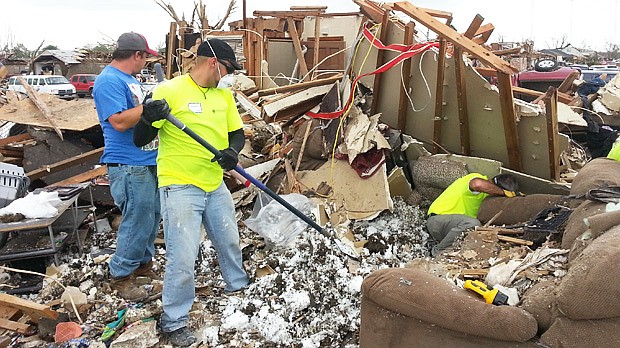- December 26, 2024
-
-
Loading

Loading

Gretchen Kerr scrolled through the photos on her computer, ones that revealed only a snippet of what she and her volunteer group saw when they got to what she calls “ground zero” of where the Oklahoma tornado landed May 20.
There were cars reduced to mangled, twisted pieces of metal, a tornado siren meant to save lives torn off its heavy-duty beam and lying with the rest of the piles of metal and wood that used to be something. There were unimaginable scenes of bark ripped off trees and wooden two-by-fours piercing cement blocks like arrows.
They saw the memorial at the tornado-ravaged Plaza Towers Elementary School – crosses, stuffed animals and little colorful pinwheels left in remembrance of seven young lives lost there. Set against the backdrop of a mountain of ruin, the memorial showed off a morsel of the incredible strength and hope she’d witnessed working with the Moore, Okla., community.
Kerr and the 17 other volunteers from Longwood’s Northland Church expected incredible destruction when they went to Moore to help the many tornado victims, but what they saw still left them awestruck.
“I’ve never seen that kind of devastation,” Kerr said. “This was as far as the eye could see of just rubble, broken homes, no walls, just flattened, flattened.”
They arrived just two days after the EF5 – the strongest possible rating – tornado touched down, killing 24 people and ripping apart Oklahoma City and its suburb of Moore.
Kerr, who is the executive director of distributed service for Northland, responded to a call for help from a former staff member at their church, who is now a pastor at Journey Church in Norman, Okla., just a couple miles away from where the tornado hit. Journey became a home base for many volunteers and those who had lost their homes and needed help, as well as the Northland volunteers, who slept on the floor after their 14-hour workdays.
To learn more about Northland Church and their volunteer work, visit northlandchurch.net. They travel locally with their mobile kitchen and are always looking for new ways to help, contact them online or at 407-949-4000.
Northland’s disaster team has traveled to many places to help others in need: from Louisiana and New York, where they assisted victims of Hurricanes Katrina and Sandy, all the way to Haiti after the earthquake in 2010.
The Moore volunteer group brought along their 24-foot mobile kitchen and served hot meals at the center of the tornado’s path, feeding those still searching their homes for some semblance of their lives before all the destruction. Before their homes became a wasteland of splintered wood and broken glass. Before the green trees that lined their neighborhoods had each leaf sucked off, leaving bare, grey stumps.
“For miles and miles and miles there’s nothing but twigs and broken things,” Kerr said. “The thing that sticks with me is the vastness of the storm and the gross destruction – it’s almost like your head and mind can’t put that together … It doesn’t make sense to you.”
Despite all that, she said, the people are hopeful, and Northland’s team helped them look for pieces of home, of life in the rubble. Many people were looking for electronics and camera cards full of priceless photos, along with sentimental items like wedding rings and service medals. One homeowner desperately searched for two handkerchiefs left to her by her grandmother, irreplaceable family mementos. During two different searches, the team found the hankies, and the woman cried bittersweet tears.
“She would come in and out of despair,” Kerr said. “That’s typical, they would be strong and then something would hit them and they would break down.”
The only thing to do in that situation is to comfort the people, said Judy Head, a full-time staff volunteer at Northland who also took the trip to Moore.
“We hug them, we listen to them,” she said.
And on that Saturday after the tornado hit, many were doing the same. Kerr said tens of thousands of people were out helping clear debris and looking for valuables. At Journey there was a board pinned with family photos found by the community, waiting to be claimed. Head remembers a woman coming in with a box filled to the brim with some family’s photographic memories. She’d raced to save them from the edge of a bulldozer’s shovel, hoping they’d be reunited with the faces on the photos.
By the end of a week, the community was ready to move on, and Kerr could see their work was done. Insurance claims were being filed and families were making plans for their future homes. A man, with his home in pieces behind him, began working on his lawn, taking the edger to his mangled yard.
“He wanted to get back to normal,” Head said.